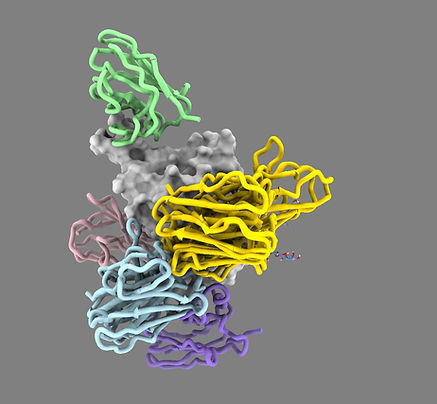


Research Interests
Our lab is captivated by the boundless potential of antibodies, camelid nanobodies and their applications in biomedical science. We have developed hybrid proteomic technologies to decode the diverse landscape of serum-circulating nanobodies. This innovative approach enables us to uncover an unprecedented repertoire of high-affinity nanobodies that target distinct regions of antigens. These nanobodies offer versatile tools to facilitate basic research, protein engineering, and therapeutic applications.
Expanding on this vision, we integrate computational design to better understand antigen-antibody interactions, and to accelerate antibody/nanobody discovery. By leveraging machine learning models, we design antibodies that target diverse epitopes including broadly neutralizing viral epitopes, and engineer nanobodies with enhanced disease specificity. These computational approaches enabling us to explore vast design landscapes and uncover novel therapeutic candidates with unparalleled precision.
Additionally, we are delving into the discovery of novel interactions mediated by membrane proteins, which play pivotal roles in cellular communication, signaling, and disease mechanisms. By leveraging nanobody-based tools and quantitative proteomics, we aim to map the dynamic interactomes of membrane proteins, including poorly characterized targets that regulate diverse and important cellular processes. This work not only sheds light on fundamental biological processes but also opens new avenues for therapeutic intervention and precision medicine.
Collaborators (past three years): our science thrives on interdisciplinary collaborations with experts worldwide. Collaborators include but not limited to
Structural Biology: Ian Wilson (Structure virology, Scripps), Derek Taylor (Single-particle CryoEM, Case Western Reserve), Francisco Asturias (Structure biology, University of Colorado), Cheng Zhang (GPCR, Pitt), Michael Lazarus (Structure biology), and Angela Gronenborn (NMR and structure virology, Pitt).
Computational Biology/AI: Dina Schneidman (AI/antibody modeling, Hebrew University at Jerusalem), Jerome Tubiana (Machine learning, Tel Aviv), Andrej Sali (Integrative structure modeling, UCSF), and Chris McKennan (Statistical models, Pitt).
Chemistry/Chemical Biology: Jian Jin (Mount Sinai), Phil Cole (Harvard), Min Xue (Mount Sinai), Sander Houten (Mount Sinai).
Biomedical Applications: Adolfo Garcia-Sastre (Virology, Mount Sinai), Bob Roeder (Biochemistry, Rockefeller University), Francisco Asturias (Biochemistry, University of Colorado), Paul Kenny (Addiction, Mount Sinai), Benjamin Chen (HIV), Andy Steward (Diabetes, Mount Sinai), Bill Klunk (Alzheimer’s Disease, Pitt), Karen Arnst (Biochemistry, Pitt), Mandy van Lent (Bioimaging), and Mingye Feng (Cancer Immunology, City of Hope).
These collaborations amplify our ability to tackle complex challenges at the molecular and organismal levels.


.png)

.png)



